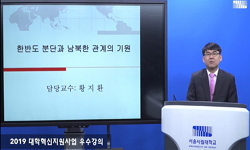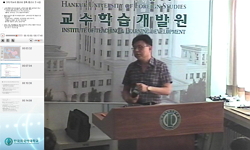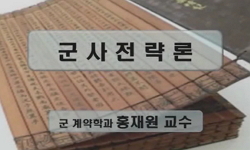From the early 1950s when the Korean War ended, South Korea and North Korea began a full-scale systemic competition. The same was true for the field of cinema. The two Koreas have tried to make technically progressive films by making each other a comp...
http://chineseinput.net/에서 pinyin(병음)방식으로 중국어를 변환할 수 있습니다.
변환된 중국어를 복사하여 사용하시면 됩니다.
- 中文 을 입력하시려면 zhongwen을 입력하시고 space를누르시면됩니다.
- 北京 을 입력하시려면 beijing을 입력하시고 space를 누르시면 됩니다.

칼라영화의 제작과 남북한의 <춘향전> = The production of color film and the Chunhyangjeon from South and North Korea
한글로보기https://www.riss.kr/link?id=A106344060
-
저자
한상언 (경희대학교)
- 발행기관
- 학술지명
- 권호사항
-
발행연도
2019
-
작성언어
Korean
-
주제어
Chunhyangjeon ; the Cold War system ; color film ; wide screen ; Competition of Ideology ; 춘향전 ; 냉전 ; 칼라영화 ; 광폭영화(와이드스크린) ; 이데올로기 경쟁
-
등재정보
KCI등재
-
자료형태
학술저널
- 발행기관 URL
-
수록면
571-599(29쪽)
-
KCI 피인용횟수
0
- DOI식별코드
- 제공처
-
0
상세조회 -
0
다운로드
부가정보
다국어 초록 (Multilingual Abstract)
South Korea and North Korea's film technology development was able to achieve rapid development by the help of the countries of the same system, because it was done within the framework of the Cold War system. Through cooperation with Soviet and Eastern communist countries, North Korea has been trained in color film and special effects techniques. This was completed when Yoon Yong-kyu's Chunhyangjeon won the prize of Cinematography at the first Moscow Film Festival. Likewise, South Korea began to produce full-fledged color films after the war. Through the joint film production with Hong Kong, there was an attempt to reliably receive color film technology and developed its own color film technology. Chunhyangjeon directed by Ahn Jonghwa was the first color film.
Soon the North Korean movie was produced. The two Chunhyangjeon, which Shin Sang-ok and Hong Sung-ki competed in 1961, utilized color widescreen technology.
In such a confrontation between South and North Korea, Chunhyangjeon was a common text that expresses the unique beauty of color films and tests the development of film technology. Somehow Chunhyangjeon, which was produced in the Korean peninsula in the late 1950s, could be recorded as an event showing the confrontation and competition of film technology in the Cold War system.
From the early 1950s when the Korean War ended, South Korea and North Korea began a full-scale systemic competition. The same was true for the field of cinema. The two Koreas have tried to make technically progressive films by making each other a competitive one. Color film and a wide screen, which started to be introduced in the 1950s, were a typical field showing their technological superiority. These film technologies were used to make the texts of Chunhyangjeon into film in both South and North Korea.
South Korea and North Korea's film technology development was able to achieve rapid development by the help of the countries of the same system, because it was done within the framework of the Cold War system. Through cooperation with Soviet and Eastern communist countries, North Korea has been trained in color film and special effects techniques. This was completed when Yoon Yong-kyu's Chunhyangjeon won the prize of Cinematography at the first Moscow Film Festival. Likewise, South Korea began to produce full-fledged color films after the war. Through the joint film production with Hong Kong, there was an attempt to reliably receive color film technology and developed its own color film technology. Chunhyangjeon directed by Ahn Jonghwa was the first color film.
Soon the North Korean movie was produced. The two Chunhyangjeon, which Shin Sang-ok and Hong Sung-ki competed in 1961, utilized color widescreen technology.
In such a confrontation between South and North Korea, Chunhyangjeon was a common text that expresses the unique beauty of color films and tests the development of film technology. Somehow Chunhyangjeon, which was produced in the Korean peninsula in the late 1950s, could be recorded as an event showing the confrontation and competition of film technology in the Cold War system.
국문 초록 (Abstract)
냉전체제의 틀 안에서 이루어진 탓에 남한과 북한의 영화기술 개발은 같은 체제의 국가들의 도움을 통해 급속한 발전을 이룩할 수 있었다. 북한은 소련과 동구 공산주의 국가들과의 협력을 통해 칼라영화 기술과 특수효과 기술들을 전수받았다. 이는 윤용규 감독이 만든 <춘향전>이 제1회 모스크바영화제에서 촬영상을 획득하면서 일단락되었다. 남한도 마찬가지로 전쟁 이후부터 본격적인 칼라영화 제작에 들어갔다. 이중 홍콩과의 합작영화 제작을 통해 칼라영화 기술을 안정적으로 받아들이려는 시도가 있었으며 자체적인 칼라영화 기술을 개발하기도 하였다. 그렇게 만들어진 첫 번째 칼라영화는 안종화가 연출한 <춘향전>이다. 곧이어 북한의 <춘향전>에 뒤지지 않는 영화의 제작이 이루어지는데 1961년 신상옥과 홍성기가 경쟁했던 두 편의 <춘향전>은 칼라와이드스크린 기술이 활용되었다.
이처럼 남과 북의 체제 대결에서 <춘향전>은 칼라영화가 지닌 독특한 아름다움을 표현하고 영화기술의 발전을 테스트 하는 공통된 텍스트였다. 어찌 보면 1950년대 말 한반도에서 제작되었던 여러 편의 춘향전은 냉전 하 한반도에서 영화기술의 대결과 경쟁을 보여주는 한 사건으로 기록될 수 있을 것이다.
한국전쟁이 끝난 1950년대 초반부터 남한과 북한은 본격적인 체제경쟁을 시작했다. 영화분야도 마찬가지였다. 남북은 서로를 경쟁상대로 삼아 기술적으로 진보적인 영화를 만들기 위해 노력...
한국전쟁이 끝난 1950년대 초반부터 남한과 북한은 본격적인 체제경쟁을 시작했다. 영화분야도 마찬가지였다. 남북은 서로를 경쟁상대로 삼아 기술적으로 진보적인 영화를 만들기 위해 노력했다. 1950년대 본격적으로 도입되기 시작한 칼라영화와 와이드스크린은 자신들의 체제가 보다 기술적 우위에 있다는 점을 대내외에 보여주는 대표적인 분야였다. 이러한 영화기술은 공교롭게도 남한과 북한 모두 <춘향전>의 텍스트를 영화로 만드는데 활용되었다.
냉전체제의 틀 안에서 이루어진 탓에 남한과 북한의 영화기술 개발은 같은 체제의 국가들의 도움을 통해 급속한 발전을 이룩할 수 있었다. 북한은 소련과 동구 공산주의 국가들과의 협력을 통해 칼라영화 기술과 특수효과 기술들을 전수받았다. 이는 윤용규 감독이 만든 <춘향전>이 제1회 모스크바영화제에서 촬영상을 획득하면서 일단락되었다. 남한도 마찬가지로 전쟁 이후부터 본격적인 칼라영화 제작에 들어갔다. 이중 홍콩과의 합작영화 제작을 통해 칼라영화 기술을 안정적으로 받아들이려는 시도가 있었으며 자체적인 칼라영화 기술을 개발하기도 하였다. 그렇게 만들어진 첫 번째 칼라영화는 안종화가 연출한 <춘향전>이다. 곧이어 북한의 <춘향전>에 뒤지지 않는 영화의 제작이 이루어지는데 1961년 신상옥과 홍성기가 경쟁했던 두 편의 <춘향전>은 칼라와이드스크린 기술이 활용되었다.
이처럼 남과 북의 체제 대결에서 <춘향전>은 칼라영화가 지닌 독특한 아름다움을 표현하고 영화기술의 발전을 테스트 하는 공통된 텍스트였다. 어찌 보면 1950년대 말 한반도에서 제작되었던 여러 편의 춘향전은 냉전 하 한반도에서 영화기술의 대결과 경쟁을 보여주는 한 사건으로 기록될 수 있을 것이다.
참고문헌 (Reference)
1 "홍콩에서 조선영화 상영"
2 림홍은, "춘향전 미술의 짧은 경험"
3 최은희, "최은희의 고백" 랜덤하우스 2007
4 "체코슬로바키야 만화 및 인형 영화 상영 주간"
5 오웅탁, "천연색 영화에서 유미주의를 반대하여"
6 "천연색 영화란 무엇?"
7 "질의응답"
8 김룡봉, "조선영화사(제2판)" 사회과학출판사 2013
9 "조,쏘 합작예술영화 <동방의 아침> 제작 소식" 1956
10 "영화의 시사성을 높이고저"
1 "홍콩에서 조선영화 상영"
2 림홍은, "춘향전 미술의 짧은 경험"
3 최은희, "최은희의 고백" 랜덤하우스 2007
4 "체코슬로바키야 만화 및 인형 영화 상영 주간"
5 오웅탁, "천연색 영화에서 유미주의를 반대하여"
6 "천연색 영화란 무엇?"
7 "질의응답"
8 김룡봉, "조선영화사(제2판)" 사회과학출판사 2013
9 "조,쏘 합작예술영화 <동방의 아침> 제작 소식" 1956
10 "영화의 시사성을 높이고저"
11 "영화계소식"
12 "영화계소식"
13 "앞다투는六十篇興行街空前不景氣에도 지치지 않는 映畵製作界"
14 서만일, "씨네마 스코프의 매력" 1956
15 정준채, "쏘련 영화가 우리 영화에 준 영향" 1957
16 "불란서 영화인들이 제작하는 광폭 예술영화 ≪모란봉≫(가제)"
17 윤룡규, "민족 고전을 영화화하고"
18 "만화영화제작단을 찾아서"
19 신상옥, "난, 영화였다" 랜덤하우스 2007
20 "김걸, 조선 영화 발전에 기울여진 위대한 쏘련의 원조"
21 "국립영화촬영소가 걸어온 길" 1956
22 "국내 문화예술 단신" 1956
23 "강화된 영화연기 진영"
24 "製協 兩派로 分立"
25 "景武臺를 禮訪亞洲映畵祭에參席했던一行"
26 "春香의 苦悶"
27 "國産映畵界劃期的發展總天然色처음으로 成功"
28 "≪동방의 아침≫ 촬영 소식"
29 "[광고]總天然色春香傳製作에 際하여"
동일학술지(권/호) 다른 논문
-
- 구보학회
- 김경수
- 2019
- KCI등재
-
의미인의 문학사, 그 체계와 의의: 김윤식의 문학사 연구에 대하여
- 구보학회
- 문흥술
- 2019
- KCI등재
-
- 구보학회
- 서영채
- 2019
- KCI등재
-
기형도와 90년대 -‘환멸’이라는 형식과 ‘선언’을 대신한 ‘잠언’
- 구보학회
- 조연정
- 2019
- KCI등재
분석정보
인용정보 인용지수 설명보기
학술지 이력
| 연월일 | 이력구분 | 이력상세 | 등재구분 |
|---|---|---|---|
| 2028 | 평가예정 | 재인증평가 신청대상 (재인증) | |
| 2022-01-01 | 평가 | 등재학술지 유지 (재인증) |  |
| 2019-01-01 | 평가 | 등재학술지 유지 (계속평가) |  |
| 2016-01-01 | 평가 | 등재학술지 선정 (계속평가) |  |
| 2014-01-01 | 평가 | 등재후보학술지 선정 (신규평가) |  |
학술지 인용정보
| 기준연도 | WOS-KCI 통합IF(2년) | KCIF(2년) | KCIF(3년) |
|---|---|---|---|
| 2016 | 0.64 | 0.64 | 0 |
| KCIF(4년) | KCIF(5년) | 중심성지수(3년) | 즉시성지수 |
| 0 | 0 | 0 | 0 |




 KCI
KCI






